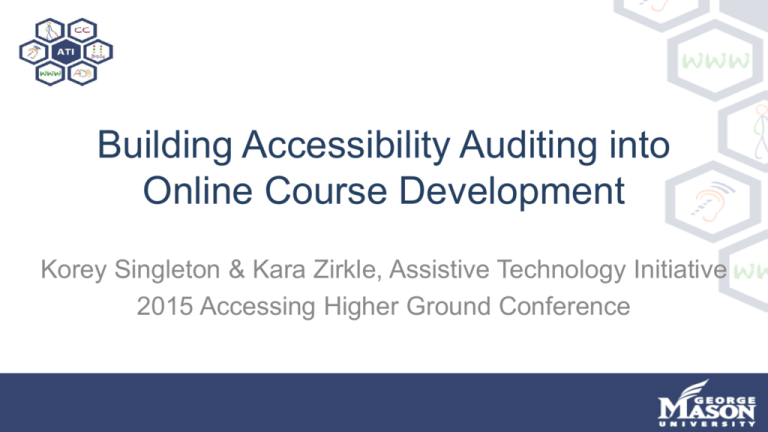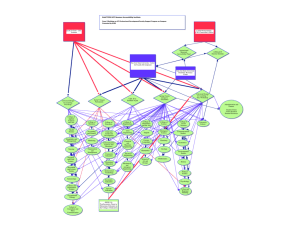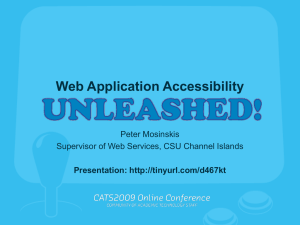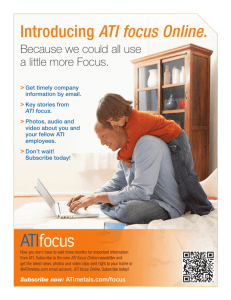Building Accessibility Auditing into course development
advertisement

Building Accessibility Auditing into Online Course Development Korey Singleton & Kara Zirkle, Assistive Technology Initiative 2015 Accessing Higher Ground Conference What we’ll cover • • • • • Our Office Online Course Development @ Mason Integrating Accessibility Learn from our Experiences Q&A Mason, ATI Mission, Services, Staffing ABOUT US George Mason University • Enrollment (Fall 2014) – ~34k students • Faculty – 1246 FT Instructional faculty – 169 FT Research faculty – 383 PT faculty FTE • Campus locations – US: Fairfax, Arlington, Prince William (Manassas, VA), and Loudoun (Sterling, VA) – International: Songdo (Korea) • More info…http://about.gmu.edu/ ATI’s Mission …to ensure equivalent access to electronic and IT resources for members of the Mason community... ATI Services • Accessible Text (e-text conversion/OCR) & Media – Provision of accessible text to students, faculty, and staff with print-related disabilities (referral only). – Provision of accessible media: closed captioning and audio description. • Web Accessibility – Section 508/Web Accessibility Training and Support for Mason employees and students. – Web Accessibility Testing for all Mason websites and web-based resources used in the classroom. – Policy and Procurement Review for Accessibility • Assistive Technology Assessments, Support, and Training – Informal assistive technology assessments and trainings for Mason students, staff, and faculty (walk-ins and referrals). – Maintenance of Assistive Technology Labs on all campuses. ATI Staff & Reporting Structure ATI operates under Compliance, Diversity, and Ethics Office • Reports up through ADA Coordinator to VP for CDE, who reports directly to University President • More information about us available at http://ati.gmu.edu VP of Compliance, Diversity and Ethics (CDE) – Julian Williams Ruth Townsend, Associate Director of CDE and ADA Coordinator Korey Singleton, Assistive Technology Initiative Manager Kara Zirkle, IT Accessibility Coordinator Courtney Shewak, Accessible Media Coordinator Program Support Specialist, Stephanie Robbins PT Accessible Media Specialist, Nancy Borck Student Worker Student Worker Critical Moments in E-Learning @Mason 2010 • Participation on DE Council • SACS Accreditation (2009) 2011 2012 • Faculty • Bb/Bb Development Collaborate Workshops for • Supplemental new online Applications teaching faculty (IDs, Library, Faculty) • AccMedia Pilot 2013 2014 • ITAG • Implementat ion of ITAG • Library Liaison Recs (Accessibility) • Doc Accessibility Pilot 2015 • DE Pilot Background, Stakeholders, Existing Models UNDERSTANDING ONLINE COURSE DEVELOPMENT AT MASON Background • Mason’s Office of Distance Education was established in early 2010 with the hiring of a new Associate Provost for Distance Education – Academic Units operated independently for years – Transition toward new senior leadership • Office’s early years focused on: – – – – Growing staff SACS Accreditation (Strategic partnerships) Establishment of policy’s and procedures Encouraging faculty members and academic programs • Strategic Partnership (ATI and DE Office) – – – – Associate Provost was an internal hire Asked by DE to assist with SACS accreditation Asked by DE to participate on hiring committees Asked DE Staff to participate on IT Accessibility Committees Stakeholders Academic Units • University has increased number of online courses and programs by ~20% per year over the past 3 years (DE Director, Personal Communication, May 2015). • Key Offices: Office of Distance Education (DE Office) Instructional Design Team (ID Team) – DE Office (Provost’s Office) – ID Team (LSS/IT Office) – Academic Units (Colleges/Schools) Existing Online Course Development Models • 4 “P”s – Proposal, Production, Pilot, and Portfolio (1-year) • OCDI – Online Course Development Institute (6-week) • Academic unit-specific Initiatives The 4P Process • • • • • • Largely driven by DE Office Each faculty member provided one-on-one ID support over course of academic year 6-week Readiness Reviews Course Portfolio Review Process after completion of pilot. End result is a fully developed course Slowly phasing out Proposal (Semester 1) Portfolio (End of Semester 4) Production (Semesters 2 & 3) Pilot (Semester 4) 6-week readiness review OCDI • Largely driven by LSS/ID Team • Faculty/staff participate in a 6week asynchronous cohort • Viewed as a more scalable going forward. • End result is one fully developed module. ATI’s Role, How it has Evolved, Next Steps INTEGRATING ACCESSIBILITY INTO THE ONLINE COURSE DEVELOPMENT PROCESS Baseline Design Considerations for Online Courses • Visual: – Provide alternative text descriptions for all meaningful graphics (images, charts, graphs, SmartArt, objects) – Provide descriptions for videos where visual content is important to understanding subject matter. – Use styles in Office documents, headers to mark-up tables or frames (for websites) – Choose applications that support keyboard navigation and are compatible with screen readers • Hearing: – Provide captions for all videos – For audio, provide transcripts • Cognitive, Neurological: – Use consistent navigation, tab order, appropriate language level ATI’s Role in Online Course Development Process How we integrate with the 4P Process… – DE Orientation Trainings – 6-week Readiness Reviews – Course Portfolio Review Process How we integrate with the OCDI… – One week of the training is dedicated solely to integrating accessible design practices Issues with Accessibility in Existing Models • 4 “P” Process: Out of the 30 items measured on the DE Office’s Course Portfolio Rating Sheet, “The course employs accessible technologies or strategies…” was the lowest scoring item in both Fall 2014 and Spring 2015 (Smucny, 2015a; Smucny, 2015b). • OCDI: Started in Spring 2015, but only looks assists with development of one module of an online course. Continuation with ID is voluntary after that. Accessible design practices are integrated into training process, but there is little follow-up beyond 6-week module. Pilot Projects • Pilots have played a significant role in the integration of accessibility in the online course development process. • Today, we will discuss today: – Accessible Media – Document Accessibility – DE Course Portfolio Reviews Current Process, Reporting, Experiences ACCESSIBLE MEDIA Moving Beyond the Pilot Project... Sept 2011 – Launched the Pilot Project! Jan 2012 – Service available to entire Mason community Over the past 3-1/2 years, we experienced a host of issues and have used that to refine this service in several ways: – – – – – – Identified our strategic partners Updated our media platform Streamlined workflows Streamlined staffing Streamlined costs Using targeted marketing Updated Accessible Media Workflow (Spring 2015) UPLOAD FINAL VIDEO AND SRT FILE TO YOUTUBE or KALTURA, THEN SEND LINK(S) OR PUSH VIDEO Outsource to 3rd party (automatic for videos over 15 minutes or immediate need) EDIT WITH YOUTUBE (Primary) YOUTUBE/KALTURA (Primary) ACCMEDIA COORDINATOR PREPS FILE EMAIL REQUEST SUBMISSION RECEIVED VIA ATI WEBSITE Updated ATI Website Website: http://ati.gmu.edu – Usability-group tested – Easier navigation – 2 important updates… Streamlined Services Request Process Captioning and Audio Description • ATI’s Accessible Media Page - http://ati.gmu.edu/accessible-media • Do-It-Yourself (Audio Description) – YouDescribe.org • Request services using either: • Accessible Media Request Form • Bulk Request form Captioning/Audio Description Cont... • Turnaround time: • • Accommodation – 7 days (faster if needed) Compliance – may take longer, depends on priority • Primary: Streaming through Kaltura, YouTube • Managing expectations... Accessibility of Media Players • Bring up Website Outsourcing Considerations Vendors we have used – 3PlayMedia, Ceilo24, eScribeSolutions, DocSoft, Automatic Sync Technologies, CloudFactory (SpeakerText), Audio Description Associates (AD) Tips when outsourcing: – Ask about cheaper per minute costs for longer turnaround times. – Bulk purchases = Reduced per minute rates – Prioritize vendors that sync with institution’s video management platform, if applicable – Transcription alone is cheaper than transcription + synchronization Managing Audio Description 1. Outsource – – Very expensive – Can be as much as $2000 per video minute Is it necessary?? – Depends….few actual requests in 4-year period 2. In-house – – YouDescribe - Audio Description Crowd-sourcing tool for YouTube videos: http://youdescribe.org Examples: • Kevin Hart/Jimmy Kimmel - http://youdescribe.ski.org/player.php?prefer_d=clairemahany&v=OPdbdjctx2I • MJ Thriller - http://youdescribe.ski.org/player.php?prefer_d=Laurae&v=sOnqjkJTMaA Managing Library Resources: Library’s Streaming Media Policy • • • • • At the request of the ATI, the library will create a streaming version of an media items that already incorporate open- or closed-captions. Access vs. Copyright – The library will defer to the ATI’s request for equivalent access to library resources. Library will seek the incorporation of captions, subtitles, etc. during procurement process. For titles already in library’s collection, library will reach out to vendor to make their resources accessible. When requested to do so by the Assistive Technology Initiative or another unit, the library will check its holdings for the presence of captions. If existing library catalog records do not accurately reflect the availability of captions, the library will attempt to update these records. Making Use of Data! • • • • • • Date of request Date needed Material Title Person making request Instructor Reason for Request – Accommodation, Compliance (DE, F2F, Web) • • • Name## Course College/School## Length of Media (minutes)* • • • • • Captioner/Vendor Date given to Captioner Date Job completed Costs per video** Location of media – Kaltura, YouTube • Delivery method – Transcripts via email, YouTube • • Delivery Date Comments ** - Very important for strategic planning purposes/grants/etc. (Avg. video length, avg. video cost, # of videos, projected costs) ## - Targeted marketing initiatives Making Sense of the Numbers! • Over 200 faculty/staff members! • Reasons for Request – – – – Compliance for DE Course – 73% Compliance for F2F Course – <1% Web Compliance – <3% Disability Accommodation – 23% (~30% costs) • Totals – Avg. video length – 15.85 min – Avg. cost/video minute – $1.79 – Avg. cost per outsourced job - $34.66 College/School/Unit Costs (% total) CEHD CHHS CHSS Compliance, Diversity, and Ethics COS CVPA Fiscal Services HR ITS 3.97% 3.00% 23.89% Office of the President 0.06% Office of the Provost SCAR School of Business SPGIA University Life Volgenau School of Engineering Grand Total 0.21% 7.48% 9.01% 3.20% 1.10% 0.11% 11.31% 1.35% 0.00% 0.31% 0.05% 34.95% 100.00% DOCUMENT ACCESSIBILITY PILOT Getting to a Pilot Project… • Fall 2013/Spring 2014/Fall 2014 – ATI Staff included as reviewers in DE Course – Reviewing entire courses (i.e., syllabus, course objectives, etc.) • Fall 2014 – Provided feedback suggesting that DE leverage ATI Office’s expertise! – Conducted a Document Accessibility Pilot to help determine the ROI • March/April 2015 – Approached about participating in pilot of open-call courses • May 2015 – Launched the Pilot (Accessibility reviewed separately)! Document Accessibility Pilot • Why - • Faculty members still struggling with what we are asking of them Pilot - Working with an 4 IDs and a single faculty member from each who is currently developing a DE course Looking at what our office can handle and what we cannot Tools being used… • ABBYY Recognition Server 4.0 (PDFs and Image) • CommonLook Office (Word and PPT) • Goal – Establish a scalable process that will support faculty members who have blind students in their courses. Build toward supporting DE. Document Accessibility Pilot – Results • Faculty/Staff Participants: • Documents Reviewed: – – – – – 5 87 ID #1 (1 PDF, 1 Word*) = 2 Fac #1 (6 PDF) = 6 ID #2 (3 PDF, 3 Word, 1 PPT) = 7 Fac #2 (1 Word, 11 PPT) = 12 Fac #3 (17 PDF, 34 Word, 5 PPT, 2 XLS) = 58 • By Document Type: – PDF (27), Word (39), PPT (16), Excel (2) Total # of pages reviewed: 1,121 * – Word encompasses .docx, .doc, .rtf, and .txt file types., PPT encompasses .ppt and .pptx. Excel encompasses .xls and .xlsx. Document Accessibility Pilot - Takeaways • What we learned? – Streamlined internal document accessibility process • Documents captured via SharePoint Doc Library • Reviewed primarily with CommonLook Office Professional • Still have some bugs to work out (e.g., alt text, final outputs, docs vs. images) – Great deal of variation in types of documents used – Better positioned to focus on accommodation at this time • Now offering service to faculty members that have a blind student enrolled in their courses. • Spring 2015 - 1 blind student, 4 courses along with orientation materials, We’ve remediated 56 documents (over 1900 pages, not including textbooks) DE COURSE PORTFOLIO REVIEW PILOT How we got to the DE Course Review Pilot… • Two ATI staff members had participated in the DE Office’s Standard Course Portfolio review process (Spring & Fall 2014). – Reviews involved several stakeholders reviewing all elements of the online course (syllabus, course objectives, learning objectives, accessibility, etc.). – Each reviewer was paid $100 for reviewing the course. • Big Problem: – Other reviewers who knew little about accessibility were reviewing accessibility. – Equally, we are not course developers. • Made suggestion to DE Office to leverage expertise of our office for accessibility and let everyone else review the areas that fit with their expertise. “Open-Call” Course Review Pilot • “Open-Call” Pilot was only for online courses not supported by the ID Team or DE Office. • Two goals: – To introduce faculty teaching “rogue” online courses to the resources available through the DE Office and/or ID Team. – To investigate the feasibility of this accessibility review process. • We reviewed 6 courses across several disciplines (Nursing, Nutrition, Communications, Business Leadership) Sample – ATI Course Accessibility Checklist ATI Course Accessibility Checklist (Internal Use Only) Updated 5/28/2015 Includes a review of the following areas: 1. 2. 3. 4. 5. 6. 7. Syllabus and Course Readings Bb Learn Word PPT PDF Multimedia Supplemental Applications The following checklist verifies that the instructional documents, audio, and video content used in Mason’s distance education courses are in accordance with Section 508 and WCAG 2.0 Level AA accessibility guidelines. While not a comprehensive review of all the areas covered by these guidelines, this checklist does examine areas that would have the most significant impact on the ability of assistive technology users to independently access their instructional materials (e.g., al text, keyboard navigation, captions, transcripts, etc.). PLEASE NOTE: This is NOT a comprehensive review of the accessibility of the faculty member’s course. The reviewers will examine snapshots (i.e., Course readings, LMS layout/structure, 2-3 documents of each type – i.e., Word/PDF/PPT, 2-3 videos, and supplemental applications) of the elements highlighted in the table below and provide feedback/guidance to the instructor on how to correct any accessibility issues that are identified. UNDERSTANDING THE REVIEW PROCESS: Reviewers examined selected examples of the elements highlighted in the attached checklist (i.e., course readings, LMS layout/structure, 2-3 documents of each type – i.e., Word/PDF/PPT, 2-3 videos, and supplemental applications) and provided feedback and resources for the instructor on how best to remediate any accessibility issues that were identified. Tools used for testing accessibility: · · Website Accessibility Reviews – WAVE Toolbar MS Office Accessibility Reviews – Built-in MS Office Accessibility Checker Term: Professor: Course Evaluated: Reviewer: 0.0 – Syllabus and Textbooks/Course Readings (Required and Supplemental) ID 0.1 0.2 Textbooks/Course Readings Is an electronic equivalent provided for all print reading materials? Yes No N/A Yes No N/A Do all web articles/readings have a PDF/Word version available? 0.3 Syllabus Course syllabus includes disability statement? 0.4 Instructor offers multiple formats/options for “Open Call” Pilot Project Results (May 2015) cont.… Issue Identified PPT inaccessible Word inaccessible Videos not captioned and/or transcribed Video platform inaccessible Bb Course Structure Improper hyperlink text Supplemental app/website Course #1 Course #2 Course #3 Course #4 X X X X Course #5 X X X X X X X X X X X X X Course #6 X X X X X X “DE-Supported” Portfolio Review Results (Sept/Oct 2015) cont.… Issue Identified Course #1 Course #2 Course #3 Course #4 Course #5 Course #6 Course #7 X X X X X X PPT inaccessible Word inaccessible PDF Inaccessible X Videos not captioned and/or transcribed X Video platform inaccessible X X X X Bb Course Structure X Improper hyperlink text X Supplemental app/website X X X X X X X Sample – ATI Course Evaluation Document Office of Distance Education Course Portfolio Reviews Fall 2015 ATI Course Accessibility Evaluation Includes the following: • • • Priority Recommendations and Resources Understanding the Review Process (i.e., testing tools used and process) Findings As a part of the Office of Distance Education’s Open Call Course Portfolio Review process, the instructional materials used in your course (i.e., documents, audio, video, websites, and web applications) were examined to determine if they are accessible and usable by Mason students, including those with disabilities, in accordance with University Policy 1308. This is not a comprehensive evaluation of all the areas covered by this policy; rather this review focuses on those areas that have traditionally had the most significant impact on the ability of students with disabilities to independently access instructional materials (e.g., alternative text descriptions, keyboard navigation, captions, transcripts, etc.). COURSE: · · · · Term: Professor: Course Evaluated: Course Reviewer: Spring 2015 PRIORITY RECOMMENDATIONS and RESOURCES: Priority Issue Action Plan Ensure all course videos have synchronized captions and/or transcripts. Go to the ATI’s Accessible Media Request page for information on requesting this service. Ensure all course videos are streamed through an accessible video playback platform (i.e., Kaltura, YouTube). Upload course videos using the “Kaltura My Media” link in MyMason\Courses Tab. For assistance, contact the ATI Office and/or Learning Support Services. Ensure that PowerPoint Presentations and Word Documents are accessible. Visit ATI’s Guide to Creating Accessible Electronic Materials (PDF – Section 2: Part II and Part III). Visit ATI Website: Creating Accessible Documents Additional Takeaways • Web MyLabs, McGraw Hill, Cengage • Laid groundwork for DE Pilot • If a professor is using Copyrighted PPTs from a 3rd party source like McGraw Hill or Pearson, we can’t do anything about it, right? Pilot Project Results • Results – Success! Very well-received by faculty and DE Staff. Asked to participate in the larger Course Portfolio Review Process – Revenue generator! – Developed DE Course Accessibility Checklist – Reviewed 6 courses – Prioritized findings • Issues Identified! – Open Call vs. DE supported courses – Scalability Evolution since Pilot Project… • We’ve been integrated into the DE Office’s Standard Course Portfolio Review Process • We have reviewed 7 additional courses this fall – 2 by request (Sum 2015) – 5 as part of DE Office’s Standard Course Portfolio Review Process (Fall 2015) Next Steps • • • • Refined Course Accessibility Checklist Design Course Accessibility Guide as reference to checklist Work with DE Office to solicit faculty feedback (4P) Work with ID Team to solicit faculty feedback (OCDI) Important Considerations LEARN FROM OUR EXPERIENCES… Things to consider… Identify your Strategic Partners – Is your institution investing in online learning? Do you have policies and procedures – Accessibility training (i.e., captioning, document accessibility) Is accessibility already integrated into the process? – Quality Matters? OLC? Bb Course Rubric? Build off of the platform… – Canvas? Bb? D2L? Kaltura? Pinopto? Program evaluation? – Do you have a process for determining success/failure? Questions Contact Information Assistive Technology Initiative (ATI) George Mason University Aquia Building, Room 238 Office Phone: 703-993-4329 Fax: (703) 993-4743 E-mail: ati@gmu.edu Web: http://ati.gmu.edu Twitter: @AccessibleMason







